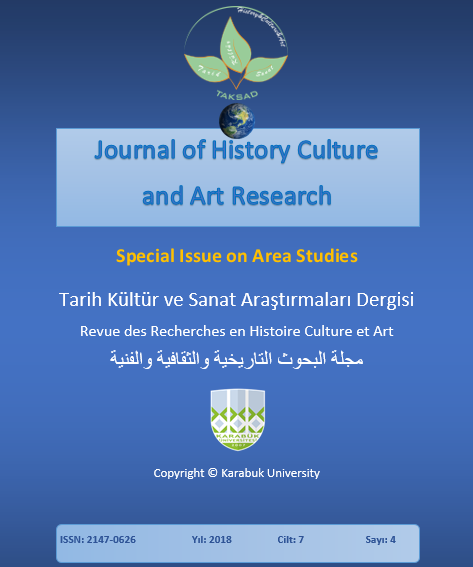The Lexico-Semantic Analysis of the Common and Various in World of Gender Picture in the English and Tatar Linguistic Cultures
DOI:
https://doi.org/10.7596/taksad.v7i4.1838Anahtar Kelimeler:
Phraseological unit- Gender picture of the world- Metonymic model of a phraseological unit- the mechanism of transfer- Substantive component.Özet
Phraseological unit is a peculiar unit of language, as complex and contradictory as language and culture. The results of a contrastive description of phraseological units cast light on the general and the differing of conceptual metaphors, which predetermines the similarities and differences of linguistic world-images. The ways of reflecting the extralinguistic reality being different for each individual language are formed in linguistic world-images. As a result, each language view of the world is characterized by cultural concepts, attitudes, and stereotypes. The value world view is a part of the linguistic world-image, since the reasoning about the good and the evil is an integral part of any society, language and culture. The universal concepts such as person, man, woman are reflected in language, and every culture comprehends its own values that must be inherent in person, man, woman. What determines these values – what is good and what is bad? An obligatory component of evaluation which directs the movement of the value judgment along the estimation scale is value stereotypes and attitudes. Linguistics demonstrates how social stereotypes influence the perception of the words such as “woman”, “man”. Social stereotypes often provoke discussions and turn into acute problems with the democratization of society, for example, a good wife – the keeper of the hearth, the hostess in the house. This paper, by comparing Tatar and English languages, examines gender structure in phraseological units.
Referanslar
Ibragimova, I. I. (1993). Contrastive Analysis of Somatic Phraseological Units (based on the materials of English and Tatar): Dissertation for Candidate of Philological Sciences. Kazan.
Kirilina, А. V. (2002). The Problems of Gender Approach to the Study of Cross-Cultural Communication. Gender as an Intrigue of Cognition. Мoscow: The MSLU Press.
Molotkov, А. I. (1977). Basics of Phraseology of the Russian Language. L.: Nauka.
Moon, R. (1994). The Analysis of Fixed Expressions in Text. In M. Coulthard (eds.), Advances in written text analysis, (pp.117-135). London: Routledge.
Moon, R. (1998). Frequencies and Forms of Phrasal Lexemes in English. In A.P. Cowie (eds.), Phraseology: Theory, analysis, and applications, (pp.79-100). Oxford: Oxford University Press.
Rosemarie, G. (1998). The Stylistic Potential of Phraseological Units in the Light of Genre Analysis. In A.P. Cowie (eds.), Phraseology: Theory, analysis, and applications, (pp.125-144). Oxford: Oxford University Press.
Smith, W. G. (1970). The Oxford Dictionary of English Proverbs Text. Oxford: Oxford University Press.
The International Dictionary of English language Text (1997). Cambridge: Cambridge University Press.
The New Encyclopedia of Britannica Text (1994). London: Encyclopedia Britannica, Inc.
Vagabov, M. V. (2003). Woman in Islam. Мoscow: Umma.
Vasyuk, V. V. (2002). Concept “Woman” in Statics and Dynamics of English Phraseology: Dissertation for Candidate of Philological Sciences.
İndir
Yayınlanmış
Nasıl Atıf Yapılır
Sayı
Bölüm
Lisans
Tarih Kültür ve Sanat Araştırmaları Dergisi'nde yayımlanan tüm çalışmalar Creative Commons 4.0 CC-BY lisansı ile lisanslanmıştır.
Bunları yapmakta özgürsünüz:
- Bu eseri her boyut ve formatta paylaşabilir — kopyalayabilir ve çoğaltabilirsiniz.
- Materyalden Adapte et — karıştır, aktar ve eserin üzerine inşa et
- her türlü amaç için, ticari amaç da dahil
Alttaki şartlar altında:
Atıf — uygun bilgiyi, lisansa linki, and ve değişiklik yapıldıysa değişiklik bilgisinivermelisiniz. Sizi veya kullanımınızı lisansörün onayladığı bilgisini içermemek kaydıyla, size uygun şekilde bu işlemleri gerçekleştirebilirsiniz.
AynıLisanslaPaylaş — Eğer materyali karıştırdınızsa, aktardınızsa ya da materyalin üzerine çalıştınızsa, ancak aynı lisans ile dağıtabilirsiniz.
- Ek sınırlamalar yoktur — Lisansın izin verdiği hakları başkaları üzerinde kanunlarla ya da teknolojiyikullanarak sınırlayamazsınız.







